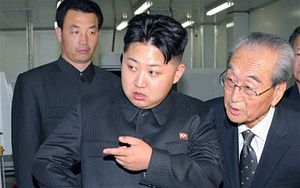Over the past week, several news outlets have reported a new Eric Schlosser book that describes the loss of a 4 megaton nuclear bomb near Goldboro, North Carolina in 1961. Although many of the details were already known, the latest information indicates that several safety protocols on the device dropped from a B-52 failed to operate, leaving far too little a margin of error for a nuclear device in a populated area.
Renewed discussion of this event has helped bring problems of nuclear accident preparedness back to the fore. The Goldboro incident is one of a family of near-nuclear accidents, situations in which a nuclear weapon came far too close to unintentional release. The Cold War experience of the United States and the Soviet Union with nuclear safety suggests a uncomfortable truth: There is a far greater likelihood that North Korea will accidentally drop a nuclear weapon on itself than on South Korea, Japan, or the United States. Managing this problem requires input from all the stakeholders, including China, and may eventually demand a rethinking of the Western position on North Korea’s nuclear program.
A 2012 Center for Strategic and International Studies presentation highlighted many of the difficulties associated with preventing a nuclear mishap in North Korea. Although the report focused on problems in production and in the fuel cycle, the difficulties associated with developing proper weapon handling techniques are even more challenging. The relatively early stage of North Korea’s nuclear program means that safety procedures remain in their infancy, and thus that the potential for accident is high. At the same time, in part because of the program, North Korea is isolated from the knowledge and expertise of the international community with respect to nuclear weapons handling and safety protocols.
Moreover, the small size of North Korea’s arsenal and the apparent paranoia of Pyongyang’s military and political leadership may necessitate a nearly constant alert status, putting pressure on personnel and increasing the chances of an accident. And indeed, this same paranoia (even, to some degree, with respect to China) may make North Korea particularly unlikely to agree to any transparency in its nuclear program.
Due to the extreme sensitivity of nuclear weapon establishments, the multilateral organizations that manage nuclear security tend to concentrate on fuel cycle issues rather than on the handling of the weapons themselves. Arrangements to transfer knowledge regarding weapon safety have historically taken place at the bilateral level, such as between the United States and the United Kingdom, the U.S. and Pakistan, and France and Israel. Unfortunately, even North Korea’s closest associates have a distaste for its nuclear program, limiting the extent to which they might desire to help, and also limiting North Korean outreach.
There is an upside to emphasizing the dangers that nuclear weapons present to their owners: the past decade of diplomacy with North Korea demonstrates that nukes tend to create more problems than they solve, as Pyongyang has purchased itself semi-permanent pariah status. Undoubtedly, North Korea’s grim experience with the utility of nuclear weapons is weighing upon Tehran, which appears to be having second thoughts regarding the wisdom of pushing forward with its own program. Noting that the actual weapons themselves are also a hassle could further adjust Tehran’s calculations.
In the next decade, one of two things will happen. Either the North Korean state will collapse, and the North Korean nuclear arsenal will be absorbed into/disarmed by South Korea, or the international community (specifically the Six Party contact group and the various international nuclear monitoring organizations) will need to accept the reality of Pyongyang’s nuclear program and move forward based on that status quo. An accidental nuclear release is a low-likelihood event, with the potential for a very high impact. Developing sufficient trust to help the DPRK safely manage its small arsenal is a smart move even for states that abhor the Kim regime.

































